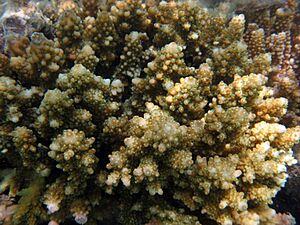Acropora listeri facts for kids
Quick facts for kids Acropora listeri |
|
|---|---|
 |
|
| Conservation status | |
| Scientific classification | |
| Synonyms | |
|
Acropora listeri is a type of coral that lives in the ocean. It belongs to a group of corals called acroporid corals. You can find this coral in warm, shallow parts of the ocean, usually where there are strong waves. It lives at depths of about 3 to 15 meters (10 to 50 feet). This coral was first described by a scientist named Brook in 1893.
What Does Acropora listeri Look Like?
This coral grows in shapes that can look like clumps or flat, table-like structures. Its branches are usually thick and not all the same shape or length. Some branches might be round like a dome, cone-shaped, or pointy.
At the ends of some branches, you might see a special tube-shaped part called an axial corallite. Other branches might not have them. The smaller, side branches, called radial corallites, are also tube-shaped and can look a bit spiky. Acropora listeri corals are usually brown or cream in color. Scientists don't know of any other corals that look exactly like this one.
Where Does Acropora listeri Live?
You can find Acropora listeri in many parts of the world's oceans. It lives in places like the Gulf of Aden, the Red Sea, and the northern Indian Ocean. It's also found near Australia, in Japan, southeast Asia, the East China Sea, and across the central and western Pacific Ocean. You can even find it near the island of Mauritius.
This coral prefers to live on the upper parts of tropical shallow reefs. These are often places where strong ocean waves hit the reef. It usually lives in water that is between 3 and 15 meters (about 10 to 50 feet) deep.
Why Is This Coral Vulnerable?
Acropora listeri is listed as a vulnerable species on the IUCN Red List. This means that its population is decreasing, and it could become endangered if things don't change. It is also listed under Appendix II of CITES, which helps control trade of species that might be threatened.
Scientists believe that many things are putting this coral at risk. These include:
- Global reduction of coral reefs: Coral reefs around the world are shrinking.
- Rising ocean temperatures: Warmer water can cause corals to lose their color and die, a process called coral bleaching.
- Climate change: Changes in the Earth's climate affect ocean conditions.
- Human activities: Things like pollution and damaging fishing practices can harm corals.
- Crown-of-thorns starfish: These starfish (Acanthaster planci) eat corals.
- Diseases: Corals can get sick, just like other living things.
Scientists don't know the exact number of Acropora listeri corals left, but they are concerned about its future.


